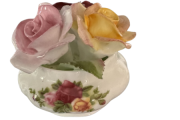Immediately after hearing the shift change report at 4 pm, each nurse assessed her assigned patients and helped them as necessary, to prepare for their evening meal. The dinner tray cart was delivered to the unit by Kitchen staff just before 5 pm; so we nurses started walking meal trays down the hall to the patients. By 6 pm all meal trays had been picked up by nursing staff and piled back onto the meal tray cart for retrieval by the Kitchen staff. Visiting hours began at 7pm and ended exactly one hour later. At precisely 8 pm, an announcement was made over the PA system that visiting hours were over and visitors were asked to leave promptly. The announcement was reinforced by the arrival of a Security Guard who walked down the hall, stopping at every room and asking stragglers to leave. There were rarely any exceptions to the 8 pm departure rule.
Within minutes of the announcement asking visitors to leave, my team members gathered at the end of the A half of the ward to begin HS rounds. The Latin abbreviation HS was, and still is, loosely translated to mean bed time. A wheeled cart was loaded up with clean sheets, towels, draw sheets, patient gowns, tiny bars of soap, back rub lotion and baby powder. Another cart carrying water, juices, crackers and cookies, followed to provide bedtime nutrition for patients.
Working in pairs, nurses on both Teams A and B changed bed linens, gave back rubs, and offered patients cookies and juice as bed time nutrition. The back rub was standard nursing practice in hospitals at the time and continued to be so for at least a decade after my graduation. The bed bath and the back rub were fundamentals of nursing care. Early in our first semester, we had been taught that a two minute, soothing back rub was effective in relaxing the patient for sleep. So we all mastered the technique and applied ourselves deliberately to our patients’ bedtime comfort.
In seemingly no time at all, the patients in the first room had been prepared for sleep and my team mate and I moved on down the hall with our carts. In one room after the other, our tasks were repeated until finally, all patients had been settled for bed. Meanwhile, the Medication Nurse had been in the Medication Room at the nurses’ station preparing the patients’ bedtime medications.
Prescription medications sent from the hospital Pharmacy were stored in small, pigeon hole compartments built into the wall of the Medication Room, each identified by patient room number. Working from the Nursing Kardex, a type of flip chart containing a set of hand written notes for each patient, the Medication Nurse double checked all the medications ordered for the patient against the pill bottle labels in the patient’s medication compartment. She then proceeded to pour out the requisite pills into tiny white paper cups, similar to those now found in fast food restaurants in which to pour condiments. Each paper cup sat adjacent to a tiny metal place card holder containing in its tines, a paper ticket on which was written the patient’s name and room number. Once each medication cup was filled and placed on a cafeteria sized tray, the Med Nurse made her way down the hall to each patient’s room delivering their bedtime pills.




